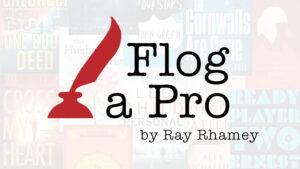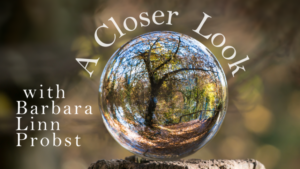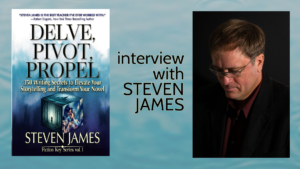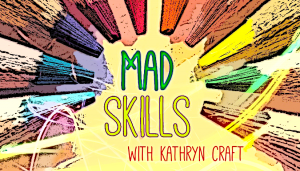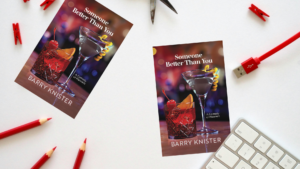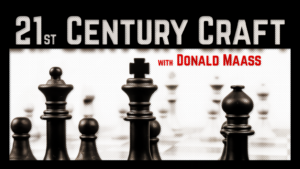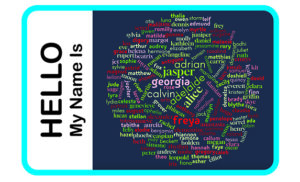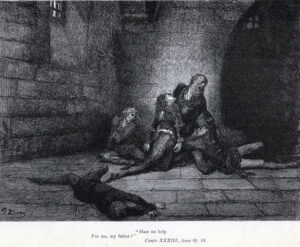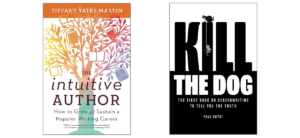CRAFT
Trained by reading hundreds of submissions, editors and agents often make their read/not-read decision on the first page. In a customarily formatted book manuscript with chapters starting about 1/3 of the way down the page (double-spaced, 1-inch margins, 12-point type), there are 16 or 17 lines on the first page.
Here’s the question:
Would you pay good money to read the rest of the chapter? With 50 chapters in a book that costs $15, each chapter would be “worth” 30 cents.
So, before you read the excerpt, take 30 cents from your pocket or purse. When you’re done, decide what to do with those three dimes or the quarter and a nickel. It’s not much, but think of paying 30 cents for the rest of the chapter every time you sample a book’s first page. In a sense, time is money for a literary agent working her way through a raft of submissions, and she is spending that resource whenever she turns a page.
Please judge by storytelling quality, not by genre or content—some reject an opening page immediately because of genre, but that’s not a good-enough reason when the point is to analyze for storytelling strength.
How strong is the opening of this novel in its storytelling—would it, all on its own, hook an agent if it was submitted by an unpublished writer?
“Y’know, there’s really no need for all this violence.”
It was common knowledge in Zilvaren City that to lie to a guardian meant death. I knew this in a first-hand, painful way that most other Zilvarens did not. Almost a year ago to the day, I’d watched one of the queen’s men clad in beaten golden armor gut my neighbor for lying about his age. And before that, and far worse, I’d stood silently in the street while my mother’s throat had been split wide open, spilling jets of hot, peasant blood into the sunbaked sand.
As the handsome guardian’s hand closed around my neck now, his beautifully engraved gauntlet reflecting the glare of the twin suns overhead like a golden mirror, it was a miracle I didn’t crack open and yield my secrets like a piece of overripe fruit. His metal-tipped fingers gouged deeper into the hollow of my throat. “Name. Age. Ward. Spit it out. Low-tier citizens aren’t permitted in the Hub,” he snarled.
Like most cities, Zilvaren, the Great and Shining Banner of the North, was fashioned after the shape of a wheel. Around the city’s outer limits, the different spokes—walls designed to keep people contained in their wards—towered fifty meters high above the shanti towns and overflowing sewers.
The guardian gave me an impatient shake. “Answer quick, girl, or I’ll have you dispatched through the fifth gate of hell directly.”
Were you moved to want more?
For today’s post I’m once again sharing the spotlight, this time with Steven James, whose writing guides are indispensable. His latest, Delve, Pivot, Propel, which arrived on December 3rd, is a crucial addition to his previous work, and it explores one particular issue I think is often neglected, inadequately addressed, or misunderstood: the pivot, aka the turning point or twist.
Steven is a critically acclaimed author of twenty novels and numerous nonfiction books that have sold more than 1 million copies. His books have won or been shortlisted for dozens of national and international awards. In addition, his stories and articles have appeared in more than eighty different publications, including the New York Times. He is also a popular keynote speaker and professional storyteller with a master’s degree in storytelling.
David: You’re one of the most relentlessly curious students of storytelling I’ve ever met. You’re always thinking about what makes stories great and how writers can accomplish that. Could you briefly outline what prompted you to take this new step in examining how stories work? What did you think was missing from other analyses of story? At one point you write, “[T]heexisting story theories were missing something essential to great stories, a moment in the narrative I’ve come to refer to as the pivot.” Was there anything else you noticed missing from existing analyses of stori
Steven: I’ve heard so many people espouse that stories have,“A beginning, a middle, and an end.” And every time I hear that, I think, “So does a bratwurst. How does the help me write my story?” Now, there’s nothing inherently wrong with this approach, but I don’t love it because it gives people the impression that a story is about a list of events—but it’s not. That’s a report. A story is about the collision of desires, not a progression of events.
Similarly, I had been trapped in the box of thinking of stories simply within a temporal framework—first act, second act, third act… inciting incident, rising action, dénouement—that sort of thing. It took me a long time to shift my thinking toward the narrative dynamics of the story and the essential elements to the story rather than continuing to parrot back the temporal aspects of story theory that we have all heard before. After all, you can have a story that works on the level of beginning, middle and end, but be entirely unsatisfying. How could that be? What were we missing? It took me a long time to realize what that was, and how to fix it in our stories.
The other aspects of story that I found were not taught enough were the pursuit and the payoff—that effective stories are not so much journeys as they are pursuits. And, you can have all the plot you want, but if there’s no emotional payoff in the story, you’re not going to impact your readers. So, I really had to step back from the paradigms I’d always heard (and taught) and take some new avenues toward a fresh perspective on story.
Stories always include tension, which is the result of desire meeting up with an obstacle. So, characters face an obstacle and, because of their unmet desire, they make purpose-infused choices that propel […]
Read MoreToday’s “ad post” is also a valuable blog post written by our own Barry Knister, detailing his experience with two editors while preparing his novel, Someone Better Than You, for publication. Enjoy!
Deciding to work with an editor is a major decision. It costs money, and calls on the writer to do something analogous to what all good parents must do: love their children enough to let them go (at least until they come home and move into the basement).
That’s what the writer does when she turns over her baby to an editor. This person will get to know the fledging novel or memoir, but usually with no knowledge of how it came to be. That means, when the baby comes home, the writer must will herself into a kind of amnesia, in order to absorb and respond to the stranger’s reactions.
That’s why I urge writers to read a report, but to then put it aside for a week or more before going back to it. Otherwise, they risk acting or reacting on impulse.
Recently, I worked with two editors on my forthcoming novel, Someone Better Than You. By coincidence, both people are past editors for Penguin. In every respect, working with these editors led to improvements in my novel. I acted on most but not all of their suggestions, and what follows is my attempt to summarize the process.
RONIT WAGMAN
I first hired Ronit in 2020 to read and report on the full manuscript of what was then titled Ashley and the Jell-O Hour. Although she liked the story (“the world of the novel and the characters that dwelled in it felt deeply authentic to me”), she had several major criticisms.
AGENCY
In the version Ronit read, my main character Brady “Buzz” Ritz is a retired newspaper editor. His life is upended when he publishes a book of his anonymously published satirical columns. He blunders mightily by publishing the book’s second edition under his own name.
In this first version, Brady’s book comes about through the actions of others. The editor of Grumble (the little magazine that first published his column) talks Brady into developing a book of his work. Ritz’s best friend from his newspaper days gets an agent friend to find a publisher. Most importantly, the best friend shames Ritz into using his own name for the second edition.
As Ronit explained, I had made my main character the passive pawn of others. Someone else pushes him to develop the book, and someone else arranges for it to be published. Most importantly, someone else is responsible for Ritz publishing the second edition under his own name.
Ronit’s guidance led me to make Ritz less a passive actor, and more the responsible agent for his story. He still gets the idea for the book from his editor, but as Ronit pointed out, no agent would take on such a manuscript from an “anonymous” writer—because no publisher would be interested in such a book.
So, I replaced a commercial publisher with a university press whose editor has the freedom to publish something by an unknown writer. I also got rid of the idea of a second edition. Once I made these changes, I was free to make Brady responsible for the […]
Read MoreDesign by Camille LeMoine
This is the eighth installment of these nerdy linguistic posts, an accidental series I stumbled into on seeing how many of the Writer Unboxed community share my appreciation for the delights and idiosyncrasies of words.
Generally I like to approach these posts from a fairly light and irreverent perspective, but today, to borrow from Hamilton, can I be real a second? For just a millisecond? Let down my guard and tell the people how I feel a second?
For all our gleeful enjoyment of the many vagaries of words, they are among the most powerful forces of society and history, which makes authors the formidable warriors who craft and wield them. As the cliché goes, the pen is infinitely mightier than the sword.
And like any warrior, we can choose to use our sword to destroy or to build.
Heroes Rise in Darkness
How many stories have you read where the hero triumphantly rides into a world where all is good and right and bending toward justice? That wouldn’t be much of a tale to tell; what makes a hero heroic is how he handles a world gone wrong.
Maybe it’s hubris or self-importance or just my own in-built bias toward creativity and the power of language, but I think authors and artists are often the heroes of history. Storytellers shed light in the darkness, increase connection and understanding, open minds and hearts. Yes, it may be politics and people who shape the course of the world, but it’s the storytellers who can help shape the ideas and mindsets behind them.
But it requires heroes, those who can transcend the oh-so-human reactions of fear and hopelessness and rage and contempt and disgust to spin a golden thread to connect one person to another, and to teach them to spin their own golden threads to draw in others. Weaving together all those tiny threads can create an unbreakable rope that can help guide all of us toward the good.
No one was ever attacked into changing their mind. Few people reexamine their views and search their heart because they were shamed or mocked or belittled or dismissed. On the contrary, those approaches are almost guaranteed to make most people entrench, to double down on their worldview, and to feed the flames of their own fear or hate or rage.
In moments like that we look to the heroes to help save us, to help create a future with promise and hope and love and good. And the heroes are those who can transcend their own darker feelings to help spread light into the world.
We are the heroes we’ve been waiting for, we wordsmiths. We have to be. The ones who understand the power and potential of that mighty tool we wield to divide or to unite.
Words Can Wound—or Heal
In 2018, outspoken comedian Sarah Silverman tweeted that she was trying to understand people who voted for Donald Trump, and was subsequently attacked on Twitter by a man trying to cut her down with his words, including a potent one intended to diminish and vilify women that many people have a visceral reaction to (it refers to female genitalia and rhymes with punt).
The understandable impulse is to strike back, particularly for those of […]
Read MoreNaming characters is my least favorite part of writing. A character’s name imparts more than just a moniker by which to differentiate actors in a plot. Names are powerful—they provide limits and possibilities to what the character might be or do. For me, the wrong name for a character throws things off in the writing. A character that has not been given the right name misbehaves. Beatrice would not speak the same way that Susan would. Ernest would choose different clothes from Roderick. Until I find the right name for a character, they don’t willingly occupy their role within the larger story.
While clearly I tend to overthink things, these expectations are extensively influenced by stereotypes and preconceptions. The connections we make when we hear someone’s name are as instantaneous, as deep-rooted, and as difficult to shift as first impressions. Getting them right is worth a little extra time and consideration.
I’m not going to tell you how to choose or derive a name—there are numbers of name generator tools on-line. I’m going to try to highlight the complexity and variety of ways in which a name can influence first impressions to help provide you with ways to assess what name best fits your character and your story.
The Power of Names:
Names create expectations, not just of the person’s individual characteristics, but also of their background:
Read More
Trained by reading hundreds of submissions, editors and agents often make their read/not-read decision on the first page. In a customarily formatted book manuscript with chapters starting about 1/3 of the way down the page (double-spaced, 1-inch margins, 12-point type), there are 16 or 17 lines on the first page.
Here’s the question:
Would you pay good money to read the rest of the chapter? With 50 chapters in a book that costs $15, each chapter would be “worth” 30 cents.
So, before you read the excerpt, take 30 cents from your pocket or purse. When you’re done, decide what to do with those three dimes or the quarter and a nickel. It’s not much, but think of paying 30 cents for the rest of the chapter every time you sample a book’s first page. In a sense, time is money for a literary agent working her way through a raft of submissions, and she is spending that resource whenever she turns a page.
Please judge by storytelling quality, not by genre or content—some reject an opening page immediately because of genre, but that’s not a good-enough reason when the point is to analyze for storytelling strength.
How strong is the opening page of this novel—would it, all on its own, hook an agent if it was submitted by an unpublished writer?
The phone rang. Again.
It was the fourth time in eight minutes.
All from the same number. All ignored by the head of homicide for the Sûreté du Québec. In the hopes it would go away.
But like most things ignored, it just got worse.
The first peal had interrupted the peace of the Gamaches’ back garden this Sunday morning in mid-August, in the Québec village of Three Pines. It broke into Armand’s thoughts as he sat on the fieldstone terrasse, absently brushing croissant flakes from his shirt and sipping strong, smooth café au lait.
While Reine-Marie read the paper, his section lay folded and warming and gathering crumbs on his lap. He tilted his head back slightly to the sun, taking a deep breath of the late-summer air. Then he contemplated the bobbing black-eyed Susans and the morning glories and sweet pea and purple Jackmanii Superba clematis climbing the fence that separated them from the mad poet next door.
It was a lovely, though ineffective, barrier. Barbed wire would have to be added.
Actually, the duck was the menace. Thank God Rosa seemed to have forgotten that she could fly. Or, more likely, she simply chose not to.
Were you moved to want more?
I’m a sucker for happy endings.
I’ve written before, though, that a lot of writers tend to shy away from them because they can easily degenerate into cliches. When the guys in the white hats always win and the guys in the black hats routinely go down in flames, endings start to get shallow and predictable. To avoid this, we get stories in which either nothing happens – stories that are more about creating character than watching character develop toward a climax – or where what happens to the characters is just the result of random, generally cruel fate.
I don’t buy that your only choice is between shallow, black-and-white morality and a descent into ennui and meaninglessness. Instead, I think we need to take a deeper look at where happy endings come from and what they mean. And a good place to start is the Middle Ages.
Happy endings, at their heart, are about justice. Good characters end well and evil ones end badly. But the medieval sense of justice runs deeper than the modern business of obeying the rules and making sure people who don’t obey the rules suffer. For them justice was based on the idea that any system – a person, a family, a community, a society, a nation – has a built-in structure to it, a way that it’s supposed to work. When you make choices that support that structure – letting go of a grudge to make way for forgiveness, supporting laws that protect vulnerable people from exploitation — you’re being just. When you work to break those structures down, you’re not. So according to medieval justice, stopping to let someone make a left turn to untie a knot in traffic is a just act. Picking up a shopping cart from the middle of the parking lot and returning it to the trolley is a just act. You’ve made a system, however small, work more the way it was intended.
The choices you make to support or break systems have consequences. Good people generally tend to do well because they are part of a healthier system. When evil people end badly, it’s not because some punishment’s been imposed from outside. Systems that break down tend to hurt the people that break them. To use a mechanical analogy (because, yes, I am a car geek), when you never change the oil in your engine, the engine isn’t punishing you by throwing a rod. There’s just a natural connection between clean oil and engine health.
You can see this connection between choices and consequences in Dante’s Inferno – or if you don’t have the patience for medieval Italian poetry, check out Larry Niven and Jerry Pournelle’s updated adaptation. The Inferno is renowned for the often gruesome punishments meted out to various types of sinners. But those punishments are always the direct (if graphic) result of the choices those sinners made in life.
In the circle of the betrayers, for instance, we meet Ugolino della Gherardesca and Archbishop Ruggieri degli Ubaldini. The real life Ugolio had been the leader of Pisa but betrayed the city to its enemies more than once. In one of the betrayals, Archbishop Ruggieri’s nephew was killed. So when the Archbishop captured Ugolino, he locked […]
Read MoreAs a connoisseur of writing how-tos (and yes, I had to look up how to spell connoisseur – and okay, “addict” might be a more accurate word), I have read a TON of them. And while I find valuable nuggets in nearly all of these books, lately I’ve noticed that many recent writing how-tos are essentially sharing slightly different flavors of some very similar core information.
So when I encounter a book about writing that offers some new (to me, at least) ways of looking at the craft, I sit up and take notice. My gushing ode to Chuck Palahniuk’s Consider This in this 2020 post is an example.
I just finished reading another such departure from mainstream writing how-tos: The Intuitive Author, by WU’s own Tiffany Yates Martin, who, in addition to being a wonderful writer and editor, is also an insanely good teacher and public speaker. Seriously, if you ever have the opportunity to attend one of Tiffany’s sessions or events, take it. And if you’re an author who speaks at literary conferences, trust me: you do NOT want to follow Tiffany. She’s that good.
Having seen Tiffany’s amazing presentation on backstory at WU’s brilliant 2022 OnCon, I knew what an extraordinary editorial mind she has, and how good she is at getting under the hood to amp up and improve your writing at multiple levels. So with The Intuitive Author, I guess I was expecting a book full of deep analysis into the mechanics of writing, along with some sophisticated editorial techniques. Instead, much of the analysis she offers in the book leans more towards the psychology and strategy involved in pursuing – and ideally, enjoying – the life of a writer.
I quickly realized I was not reading The Average Writing How-To, and I dove into the book with my curiosity piqued. (And yes, I had to double-check whether it was “piqued” or “peaked.” Got it right the first time – yay! Hey, it’s the small victories. But I digress…)
In short, The Intuitive Author is filled with insights and perspectives quite unlike those offered in the vast majority of writing how-tos currently on the market. And reading Tiffany’s book made me think about another writing how-to I’d recently read that takes a pretty big departure from most conventional writing wisdom: the provocatively titled Kill the Dog: The First Book on Screenwriting to Tell You the Truth, by author and screenwriter Paul Guyot.
What does this Guyot dude have against dogs, anyway?
Nothing, actually. Instead, the animal Guyot truly hates – and is taking a not-at-all thinly veiled swipe at – is the cat. Specifically, the cat in the well-known “Save the Cat!” series created by the late Blake Snyder.
If you’re not familiar, Snyder’s initial Save the Cat! book (STC to the cool kids) burst onto the scene in 2005 with a VERY structured set of templates for storytelling, which he reverse-engineered from studying many successful movie scripts. Targeted at aspiring screenwriters, Snyder’s methodology offered a compelling framework for them to adopt […]
Read More

